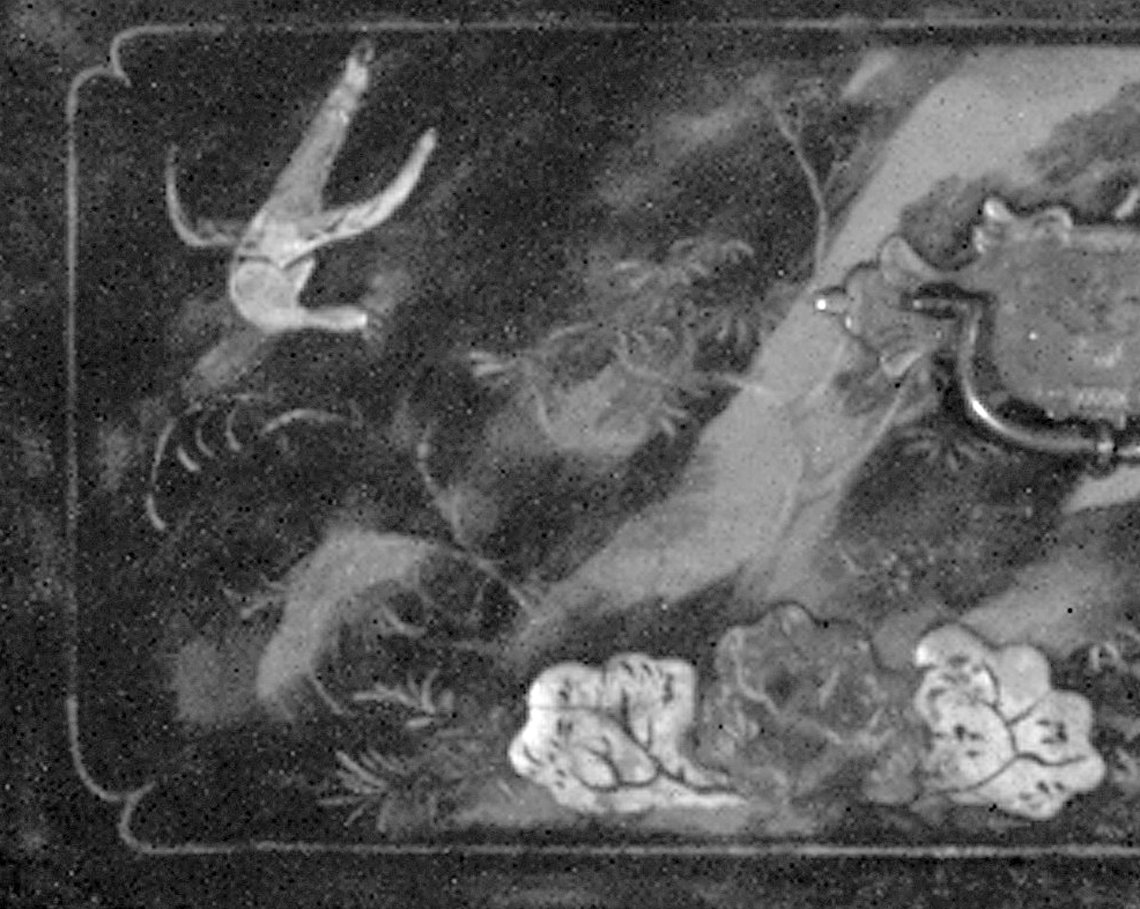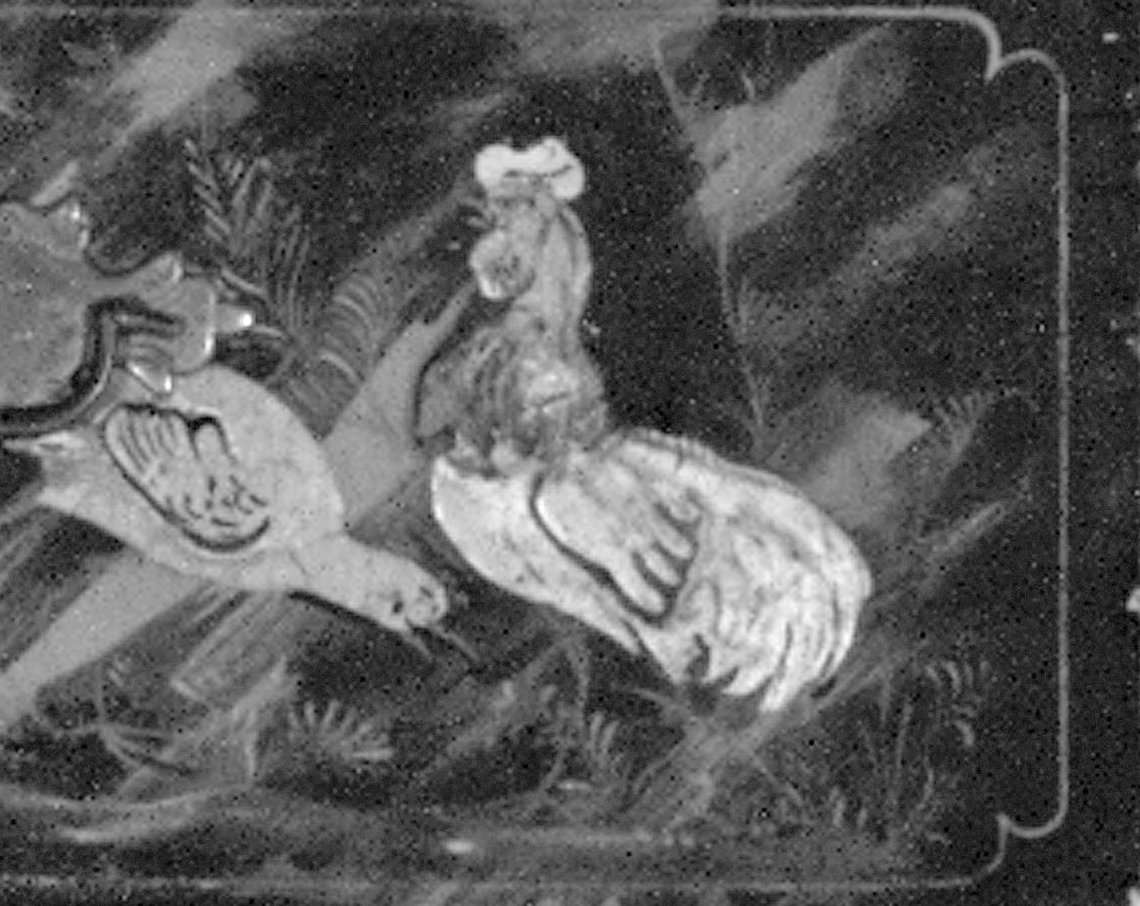Dietrich American Foundation: A John Brocas High Chest
SERIES INTRODUCTION
Over the next year, the Dietrich American Foundation will present a series of articles in these pages, each featuring an object from the collection. The findings come from an extensive furniture survey conducted during the last several years by conservator Christopher Storb, who, along with the curator of the Foundation, Deborah Rebuck, examined 144 pieces in the collection as part of the project. This was a meticulous project, and from it, great stories have been revealed.
 | |
Fig. 1: High chest of drawers by John Brocas (died 1740 ). Boston, Mass., 1733–1737. Maple, maple veneer, eastern white pine, japanned finish, brass hardware. H. 69¾ , W. 40¾ , D. 22¼ in. The Dietrich American Foundation. The original brass pull plates have the initials “I P” cast on the back, possibly for John Pulley, working in London by 1731. Photo by Gavin Ashworth. |
The Dietrich American Foundation was founded in 1963 by H. Richard Dietrich Jr. to collect and research American decorative and fine art, primarily of the eighteenth century. The collection was featured in the 20th Anniversary issue (January 2020) of Antiques & Fine Art magazine to mark the Foundation’s publication of In Pursuit of History: A Lifetime Collecting Colonial American Art and Antiques. A related exhibition, A Collector’s Vision, is on view through November 15, 2020 at the Philadelphia Museum of Art.
The spirit of the Foundation has always been one of sharing and making the collection available to the public. We believe that these works of art and artifacts enrich and inspire a fascination in history. With an eye toward presenting the collection’s strength in furniture, we are delighted to present these articles, which we see as a type of crowd sourcing exercise, where responses and information shared by readers can inform the research. New information gleaned will be provided over the course of the series. As is always the Foundation’s mission, we are excited to share the forthcoming findings and stories about people, place, and history that are revealed through our research. Contact information is in the author bio at the end of the article.
— DietrichAmericanFoundation.org
 |
THE BROCAS HIGH CHEST
John Brocas may be the most celebrated cabinetmaker whose work until now has never been identified. Robust evidence of his furniture shop in the historical record has allowed furniture historians to study his life, and now a high chest of drawers in the Dietrich American Foundation marked with his name at last gives us a glimpse of his artistic output (Fig. 1).
An English immigrant cabinetmaker, Brocas purchased land in Boston in May 1696. His shop on Union Street was destroyed by fire in 1737. At his death in 1740, his inventory included brass furniture fittings and “sundry veneers,” indicating he may have continued working at cabinetmaking after the loss of his shop. Brocas has been credited with being primarily responsible for introducing to Boston the style of dovetailed-board carcase construction developed in London in the last quarter of the seventeenth century. Until recently his work has remained elusive.
During the recent survey of the Dietrich American Foundation’s furniture collection, “Brocas” was found inscribed in graphite on the exterior surface of the backs of the majority of the drawers of a high chest (Figs. 2, 3). The circa 1733-1737 high chest is japanned, a decorative technique in imitation of Asian lacquer popular in Boston in the first half of the eighteenth-century. Though the high chest was the subject of auction house descriptions and several articles in trade papers, the “Brocas” inscriptions were not previously discovered.
 |
Fig. 2: The back of the proper right top drawer of the lower carcase of the chest. Top: a manipulated image. Bottom: the drawer in visible light. Photo by author. |
 |
Fig. 3: The back of the drawer second from the bottom of the upper carcase. The image has been manipulated to enhance the inscription. Shop markings in chalk are also present. Photo by the author. |
The Dietrich chest’s lower carcase is constructed with mortise-and-tenon joinery and cabriole legs at the four corners, a curvaceous design developed in London decades after Brocas immigrated to Boston. Laying out and shaping the curved leg would have been new to Brocas and other cabinetmakers who were trained in the earlier style of turned-leg stands. The form of the leg shows a lack of familiarity with this new way of working, the design is not as graceful or flowing as cabriole-legs on surviving Boston high chests from other makers who were more recent London immigrants and so familiar with the latest style. Brocas carved the feet on his chest to a more oval than round shape, rather than turning the feet on a lathe before shaping the legs with saws, shaves, files, and scrapers. By the middle of the century, it would become nearly universal for the pad feet of Boston cabriole-legs to be turned prior to the leg being shaped. The rear legs of the chest curve in only one direction, unlike the front legs, which curve in two directions. This working out of how to design and orient the rear cabriole-legs on stands was not uncommon during the initial period of their popularity. Cabinetmakers eventually standardized the design so that the rear legs mirror the front legs.
While the stand of the Brocas chest was made in the newest fashion, the upper carcase construction varied little from the woodworking techniques in common use at the end of the seventeenth century. This dichotomy allows the piece to represent an important transition in the history of furniture making. The carcase is a box joined at the corners with through-dovetails. Half-inch dustboards glued into dados in the sides provide lateral support. The drawers are through-dovetailed at the front and back. The drawer fronts are veneered with plain-grain maple, providing a dense, smooth surface for the japanning, while covering the exposed end grain of the dovetails of the sides of the drawers. (Other Boston makers of japanned furniture used solid maple with lapped-dovetails for their drawer fronts.) The drawer bottoms are nailed to a rebate in the front and to the edges of the sides and backs. (Running strips have subsequently been added to all of the drawers.) The tops of the drawer sides and backs are flat and sit slightly below the top of the drawer front. Double-bead moulding is nailed to the drawer surrounds on the front of the carcase. These construction details suggest an adherence to an earlier way of working.
The decorative japanned surface survives in relatively good condition with typical losses due to wear and wood movement. Varnish layers added at the end of the nineteenth or beginning of the twentieth centuries have degraded and darkened over time. The chest now appears to have a black colored ground rather than the original red-and-black “tortoiseshell” background (Fig 4). The raised and flat gilded work was also enhanced around this time. While this later work closely follows the original design, the later japanner did not possess the neat, elegant hand of the original artist (Fig. 5). Our inability to clearly discern the hand of the eighteenth-century japanner due to these later varnish and gilding layers makes attributing the work to a specific japanner problematic. Several characteristics of the decoration appear in the documented and attributed work of Robert Davis, in particular, the indented corners of the painted lines that outline the drawer fronts. Other characteristics of Davis’s work are absent.
 |  | |
 |  | |
Fig. 4: Details of the drawer front of the top long drawer, using an infrared camera. The mottled original red-and-black ground is visible under infrared light. Photo by Joe Mikuliak. | ||
 |
Fig. 5: Detail of the drawer front of the top long drawer with the original brass pull removed. The later varnish coats and strengthening of the gilt and pen work was done with the brass in place. The original japanner’s work is visible without later enhancements under the brass pulls. In comparison with the later work, the original gilt and drawn pen work has a greater delicacy. The red ground color is also visible. |
Ultimately, without a broad range of the early work of John Brocas to examine, we cannot know what influence he had on Boston’s furniture makers. Nevertheless, this high chest made at the end of his life represents an unusual opportunity to investigate the work of a cabinetmaker who had to navigate stylistic changes as well as technical developments in his craft to satisfy his clients, while continuing to work efficiently at his trade. We are now able to appreciate the work of this early American furniture maker whose life was known, but whose art was a mystery before this exciting discovery.
1. Brocas was a fully trained craftsman when he came to Boston; Benno Forman credited Brocas as introducing the William and Mary chest to the city. See Benno M. Forman “The Chest of Drawers in America, 1635-1730: The Origins of the Joined Chest of Drawers,” Winterthur Portfolio 20, no. 1 (Spring 1985): 21–26. See Edward S. Cooke Jr., “Newest Fashion Case Furniture in Boston, 1690-1725: A Transatlantic View,” p. 38, for a contemporary consideration of early eighteenth-century Boston cabinetmakers in Brock Jobe and Gerald W. R. Ward, ed., Boston Furniture 1700-1900 (Colonial Society of Massachusetts, 2016).
2. The graphite inscriptions were likely added either by Brocas or by the japanner when it entered his shop. A japanned Boston high chest is similarly inscribed on the back of the drawers with the name of the maker, John Pimm. Nancy E. Richards and Nancy Goyne Evans, New England Furniture at Winterthur: Queen Anne and Chippendale Periods (Winterthur Museum, 1997), cat. no. 160, pp. 307-310.
3. For the most recent investigation of japanning in Boston, see Tara Cederholm and Christine Thomson, “‘Tortoiseshell & Gold’: Robert Davis and the Art of Japanning in Eighteenth-Century Boston,” Brock Jobe and Gerald Ward, eds., Boston Furniture, 1700-1900 (Boston: Colonial Society of Massachusetts, 2016). This article can also be accessed online: www.colonialsociety.org/publications/3297/tortoiseshell-gold-robert-davis-and-art-japanning-eighteenth-century-boston.
4. The Dietrich high chest was sold at F. O. Bailey, Portland, Maine, July 19, 1977. It sold again at Christie’s, New York, May 5, 1979. The chest’s provenance prior to the early twentieth century is unknown.
5. Adam Bowett, English Furniture, 1660–1714: From Charles II to Queen Anne (Woodbridge, Suffolk: Antique Collectors’ Club, 2002), 49. Bowett refers to these details as “first-phase” construction, dating from 1670–1700. The double-bead moulding was commonly used after 1700.
6. Cederholm and Thomson, 61-63. Correspondence between Tara Cederholm and Chris Storb, June 2020.
Christopher Storb is a furniture conservator, woodworking historian, and wood artist. Please send comments and related research to cstorb@gmail.com, or call 610.212.5528.
 |
This article was originally published in the Autumn 2020 issue of Antiques & Fine Art magazine, a fully digitized version of which is available at www.afamag.com. AFA is affiliated with Incollect.com.
 |



























